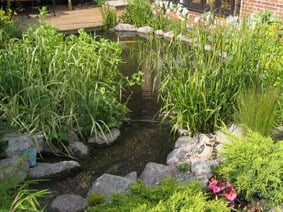
Top Tips To Protect Your Pond, Plants And Fish This Winter
11th January 2022
New Homeowners’ Guide To Pond Care
16th February 2022Winter is one of the most difficult times for someone who owns a pond to try and take care of water lilies, fish and other pond life.
With temperatures in December and January, in particular reaching freezing temperatures regularly, knowing how to prevent your pond from freezing over is essential to protect your pond.
Whilst there are dedicated anti-freezing solutions in place to avoid a pond icing over or to safely create holes in the ice when it appears, one of the most effective and long-lasting tricks relies on an object as simple as a tennis ball.
Why Is A Frozen Pond Bad?
A pond or other body of water that is entirely frozen over is potentially deadly to the fish in your pond. There needs to be a clear surface to the water for carbon dioxide to safely leave and for oxygen to safely enter, a process called aeration.
When the ice is frozen over, this process cannot happen, and the fish quickly start to use up all of the oxygen that is left, eventually dying out in the process if left for too long.
Can’t I Just Break The Ice?
Some pond owners’ reflexive reaction to seeing a sheet of ice is to shatter it, either by stomping on the surface (which we do not recommend at all) or using a hammer or pickaxe to break a hole in the ice.
Whilst this does solve the issue by creating a hole for aeration to occur, it does have the rather unfortunate side effect of potentially killing the fish through deadly vibrations and stress.
Sound waves that travel through to the bottom of the water can cause physical stress to the hibernating fish, which can kill them if too intense.
A safer method for creating an ice hole is to boil a pan of water and hold it just over the pond so it will gently melt away a hole. Gently pouring water from a kettle can work as well.
Once you have a hole the best way to avoid ice developing further is simple.
Why The Tennis Ball Trick Works
A trick that has been used for centuries involves floating a rubber ball, ping pong ball, tennis ball or inflatable ball onto the water surface, depending on the side of the lake and leaving it, checking each day the temperature drops.
You can also use a bottle filled with a saltwater solution that floats on the water.
The reason this works is that when the ball bobs and floats on the water, it creates little waves and motions in the water that stop ice from forming, and it will accentuate any movement of the water or anything underwater, helping to keep ice from developing.
The size of the ball you need depends on the size of the pond, with most garden ponds needing a tennis ball, and any larger body of water needing a football or larger-sized ball to be effective.
This, along with careful maintenance of air pumps and other pond tools can keep your pond life safe this winter.





